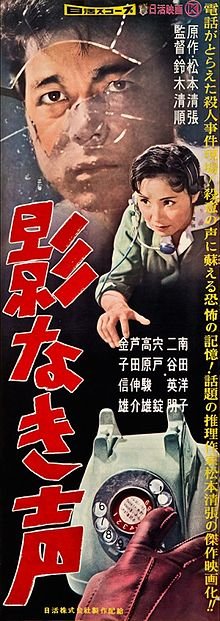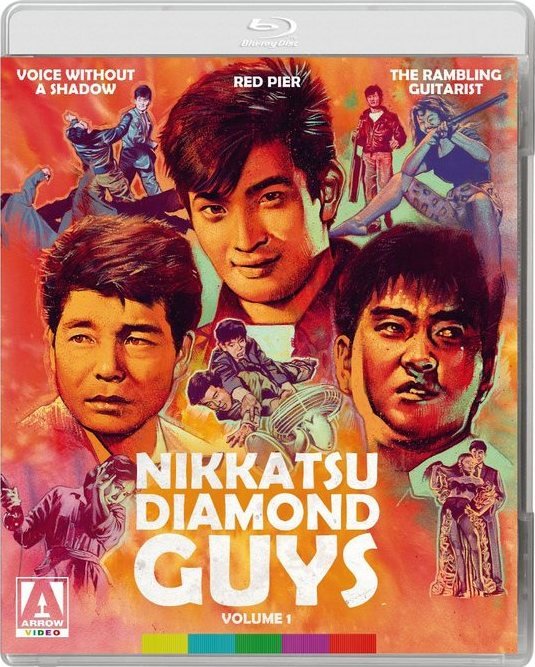VOICE WITHOUT A SHADOW: Suzuki Before The Rebellion
Seijun Suzuki is known to many cult film fans as a rebel among Japanese directors, someone who challenged the status quo of his country's studio system to produce subversive work like Tokyo Drifter and Branded To Kill. Before he moved into that rebellious phase, he made his bones in Japan's film business as a journeyman director. Voice Without A Shadow is one of four films Suzuki made in 1958 and it shows him doing his best to bring a unique style to a conventional murder mystery. Voice Without A Shadow begins with telephone operator Asako (Yoko Minamida) accidentally hearing the voice of a murderous thief when punching up a wrong number. The killer is never found and years later, she is the dutiful wife of a schlubby would-be ad exec who falls in with small-time crook Hamazaki (Jo Shishido). She realize Hamazaki is the killer when she hears his voice on the phone but he is killed shortly afterward and all clues point to her husband being her murderer. Her only hope is Ishikawa (Hideaki Natani), a good-guy reporter who is convinced there is more than meets the eye with this case and sets out to find Hamazaki's true assassin.The results are a competent programmer, albeit one that shows its age. The script does a good job of keeping the guilty party a mystery until the final reel but it's also a bit too methodical in its approach, focused more on the procedures of the police and the media rather than building suspense. As a result, there are dry stretches between thrills, even at a fairly tight 90 minute running time. Nitaki does solid work in a rather bland hero role while Minamida is undermined by a damsel-in-distress role that require her to be helpless, hysterical or both. Shishido steals every scene he's in as a nasty schemer but he and the film's interesting criminal elements are sidelined in favor of the dull-ish heroes.
Voice Without A Shadow begins with telephone operator Asako (Yoko Minamida) accidentally hearing the voice of a murderous thief when punching up a wrong number. The killer is never found and years later, she is the dutiful wife of a schlubby would-be ad exec who falls in with small-time crook Hamazaki (Jo Shishido). She realize Hamazaki is the killer when she hears his voice on the phone but he is killed shortly afterward and all clues point to her husband being her murderer. Her only hope is Ishikawa (Hideaki Natani), a good-guy reporter who is convinced there is more than meets the eye with this case and sets out to find Hamazaki's true assassin.The results are a competent programmer, albeit one that shows its age. The script does a good job of keeping the guilty party a mystery until the final reel but it's also a bit too methodical in its approach, focused more on the procedures of the police and the media rather than building suspense. As a result, there are dry stretches between thrills, even at a fairly tight 90 minute running time. Nitaki does solid work in a rather bland hero role while Minamida is undermined by a damsel-in-distress role that require her to be helpless, hysterical or both. Shishido steals every scene he's in as a nasty schemer but he and the film's interesting criminal elements are sidelined in favor of the dull-ish heroes. Ultimately, the best thing about Voice Without A Shadow is Suzuki's direction, which benefits from a level of visual invention that is ahead of its time for a late '50s production. He makes imaginative use of the widescreen frame, including a few interesting split-screen effects to stylize moments where the heroine is remembering something and some impressive flashback scenes that add a little formalistic zip to the proceedings. His approach feels modern even when the material is feeling stodgy - and you can see a glimmer of the stylist that would emerge in the '60s in his smart handling of this film.Blu-Ray Notes: This title just made its U.S. debut on home video via Nikkatsu Diamond Guys, Vol. 1. This Arrow Films release boast a strong new transfer that does well by the film's noirish black and white 'scope photography. The audio is Japanese mono, presented in lossless form with easy-to-read English subs. This release also includes the films Red Pier and The Rambling Guitarist. Extras include a couple of video profiles on Nikkatsu stars Hideaki Natani and Yujiro Ishihara by historian Jasper Sharp, trailers for the films on this set and trailers for films in the next volume of Nikkatsu Diamond Guys.
Ultimately, the best thing about Voice Without A Shadow is Suzuki's direction, which benefits from a level of visual invention that is ahead of its time for a late '50s production. He makes imaginative use of the widescreen frame, including a few interesting split-screen effects to stylize moments where the heroine is remembering something and some impressive flashback scenes that add a little formalistic zip to the proceedings. His approach feels modern even when the material is feeling stodgy - and you can see a glimmer of the stylist that would emerge in the '60s in his smart handling of this film.Blu-Ray Notes: This title just made its U.S. debut on home video via Nikkatsu Diamond Guys, Vol. 1. This Arrow Films release boast a strong new transfer that does well by the film's noirish black and white 'scope photography. The audio is Japanese mono, presented in lossless form with easy-to-read English subs. This release also includes the films Red Pier and The Rambling Guitarist. Extras include a couple of video profiles on Nikkatsu stars Hideaki Natani and Yujiro Ishihara by historian Jasper Sharp, trailers for the films on this set and trailers for films in the next volume of Nikkatsu Diamond Guys.

